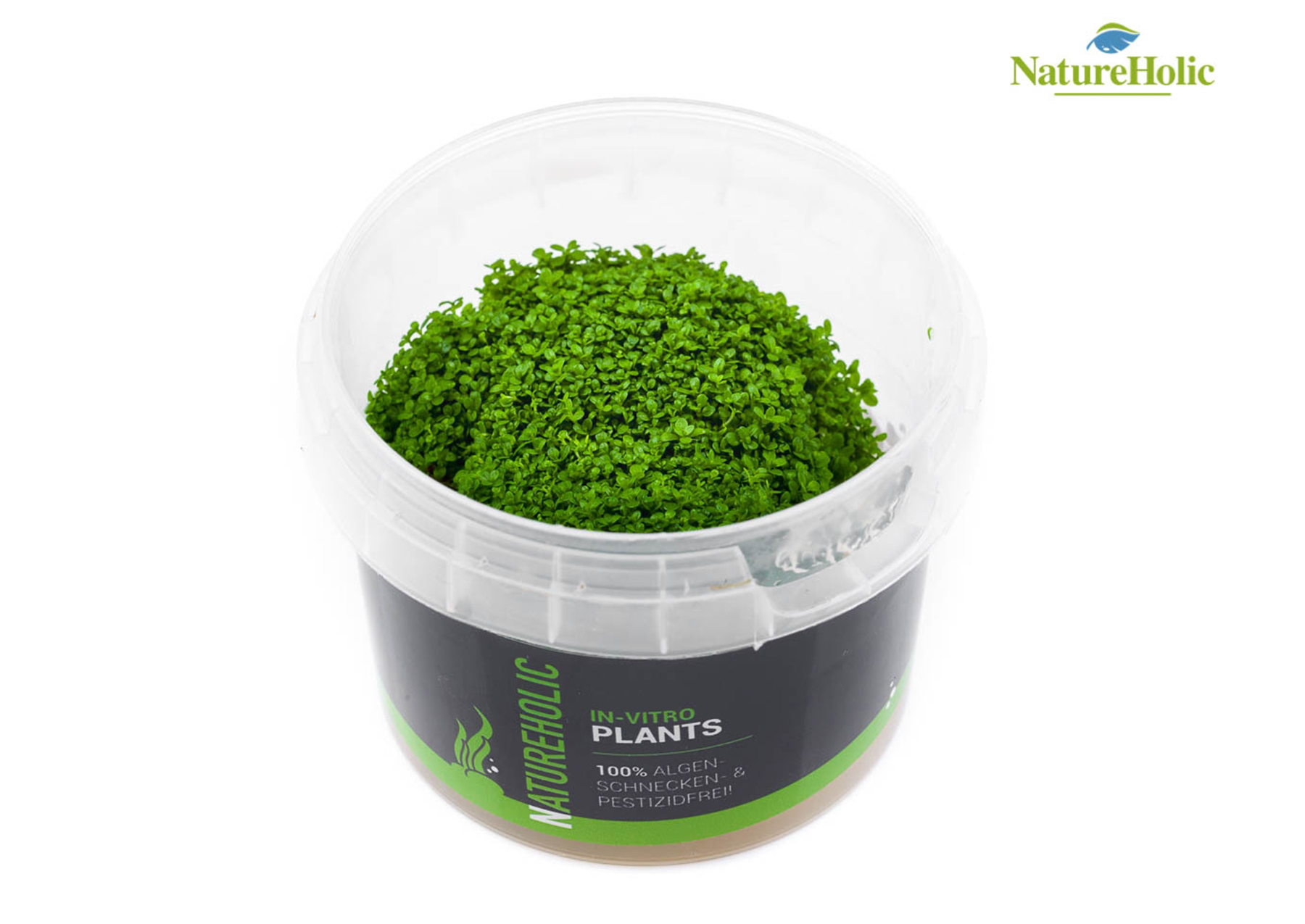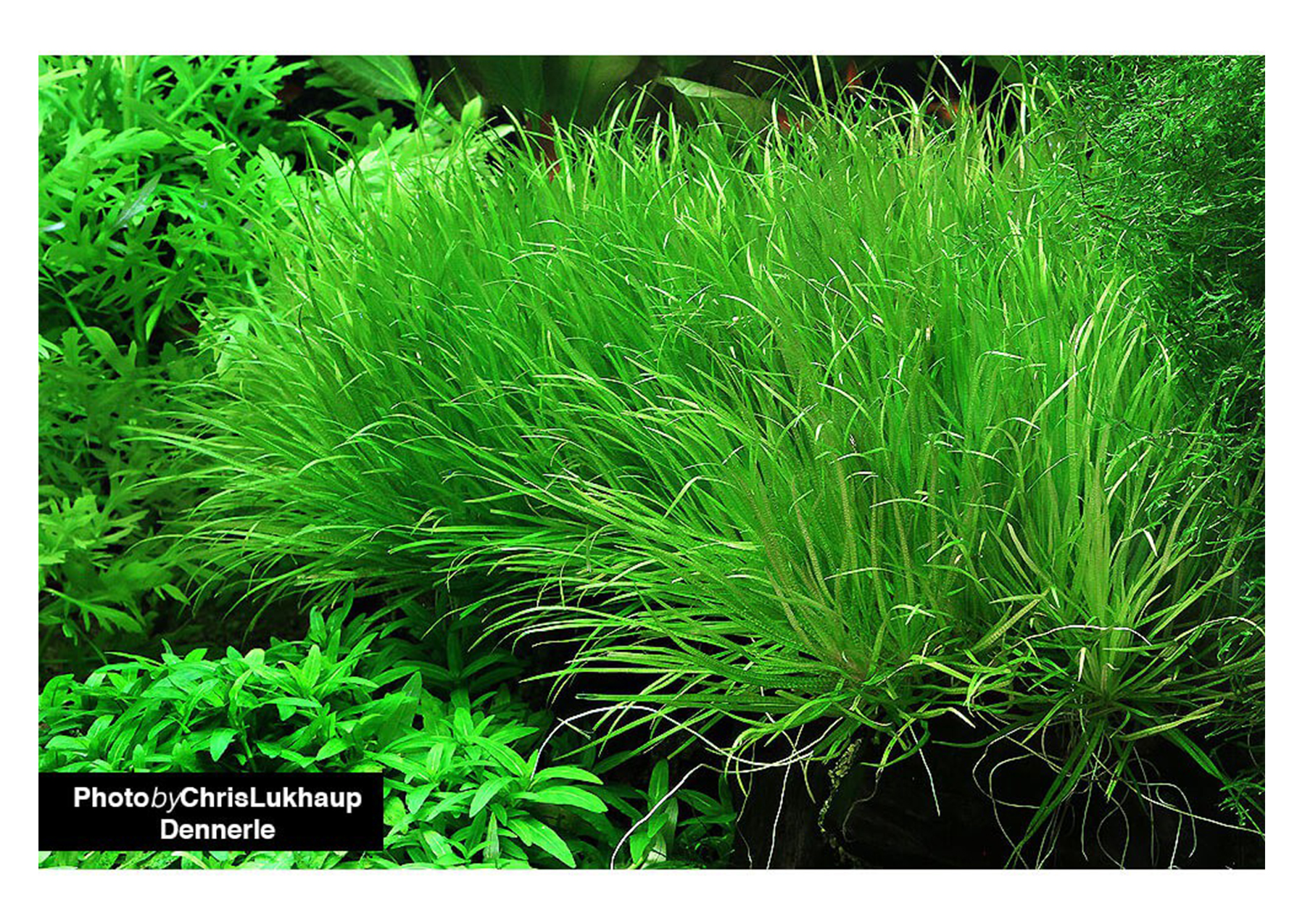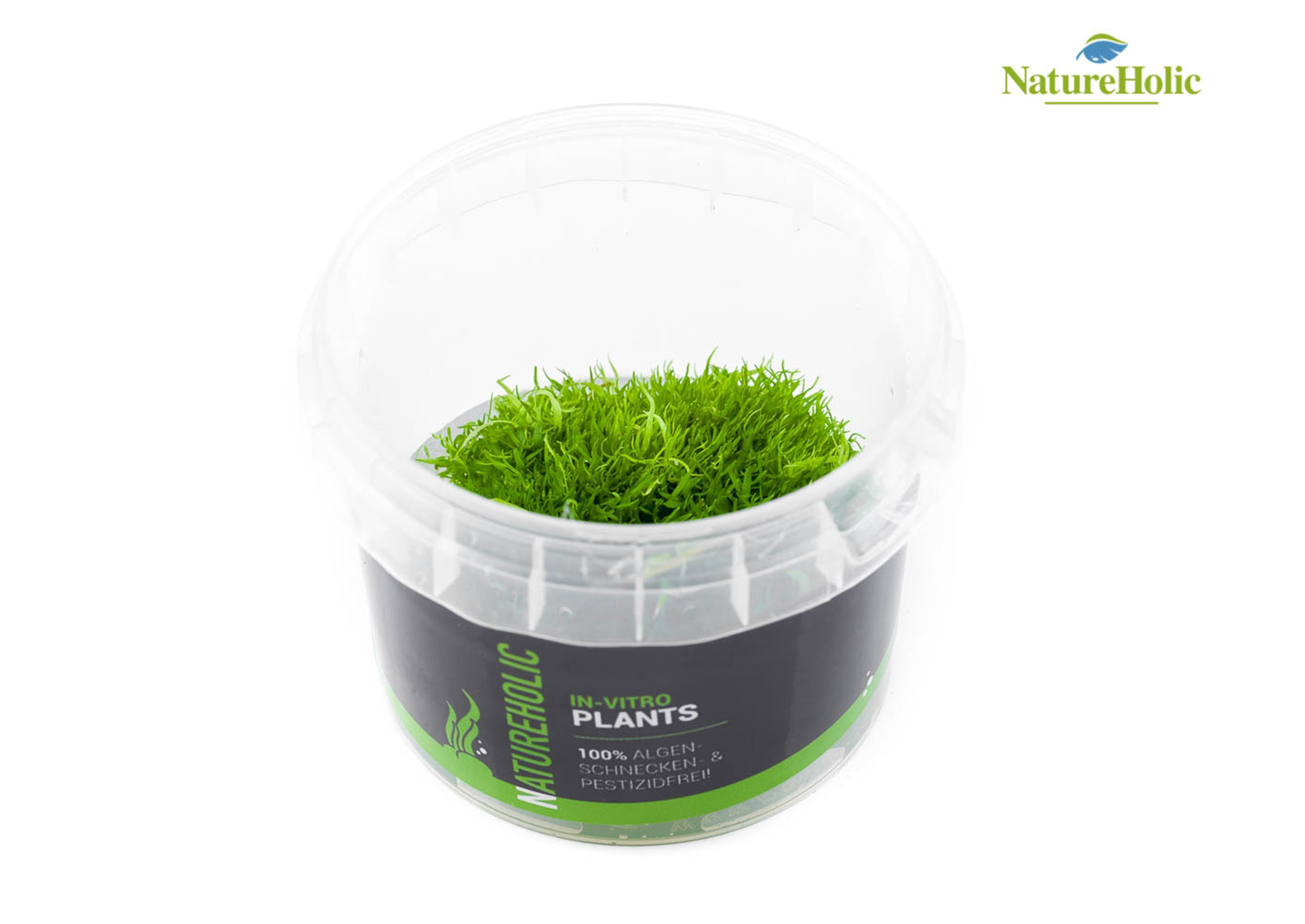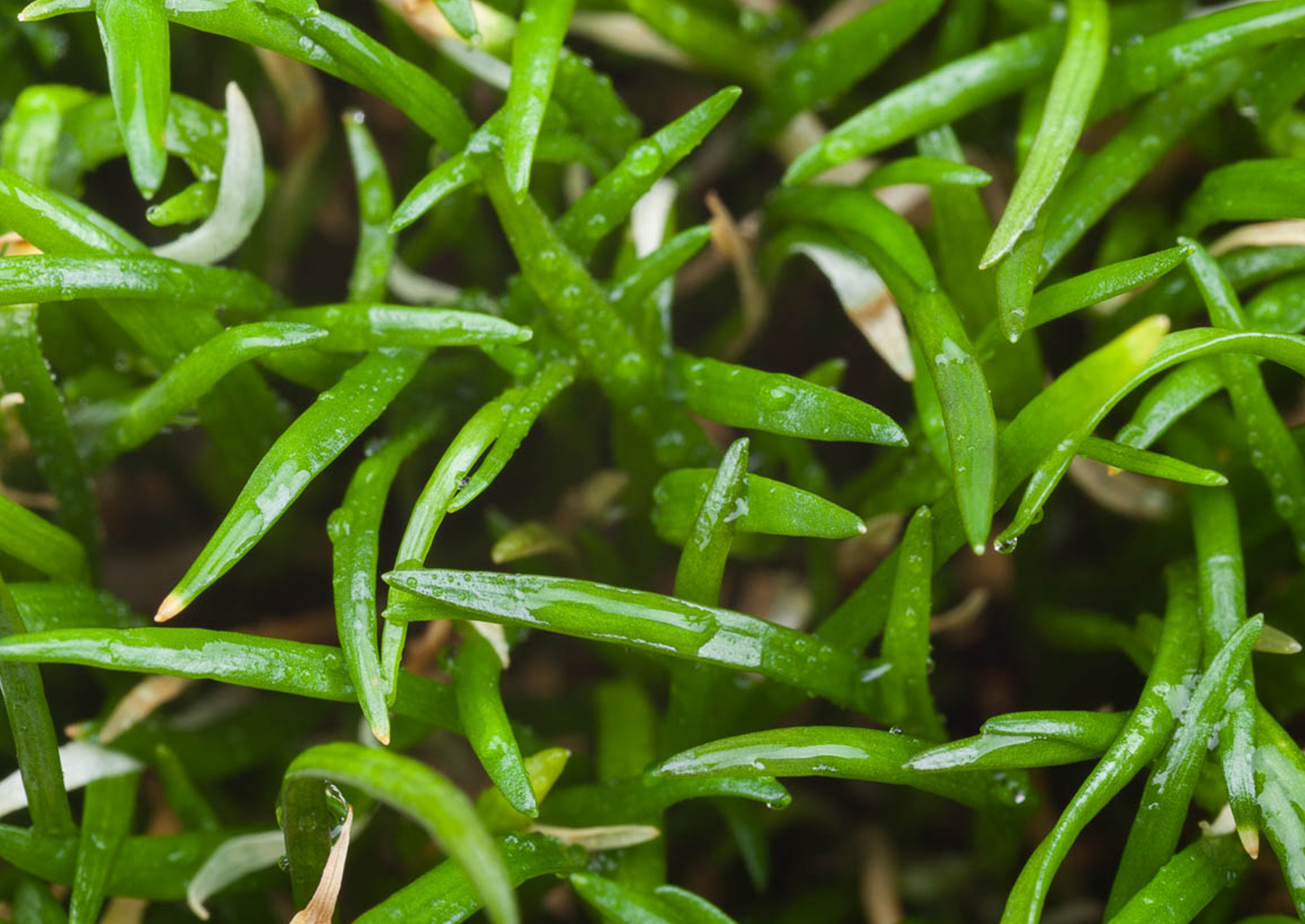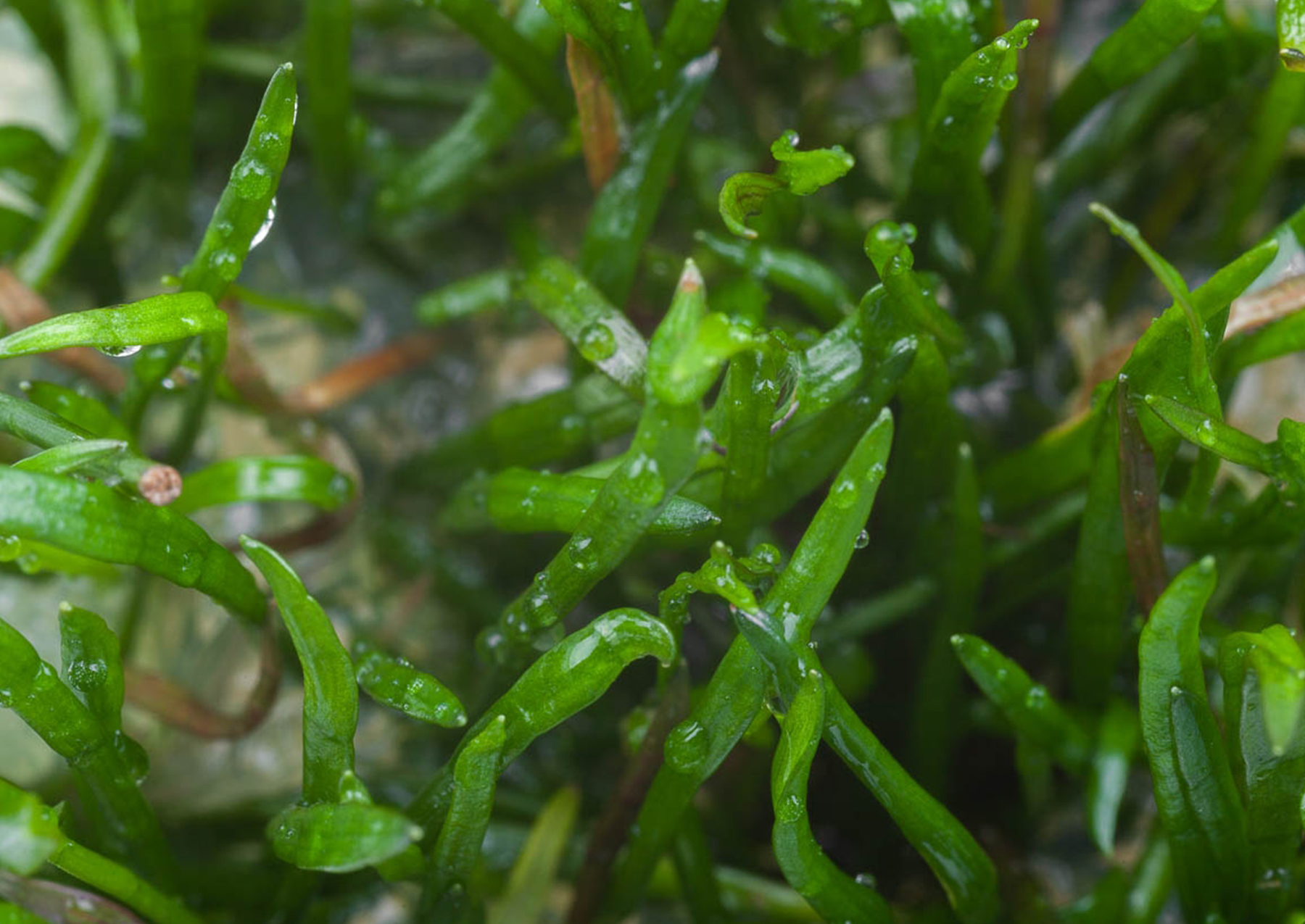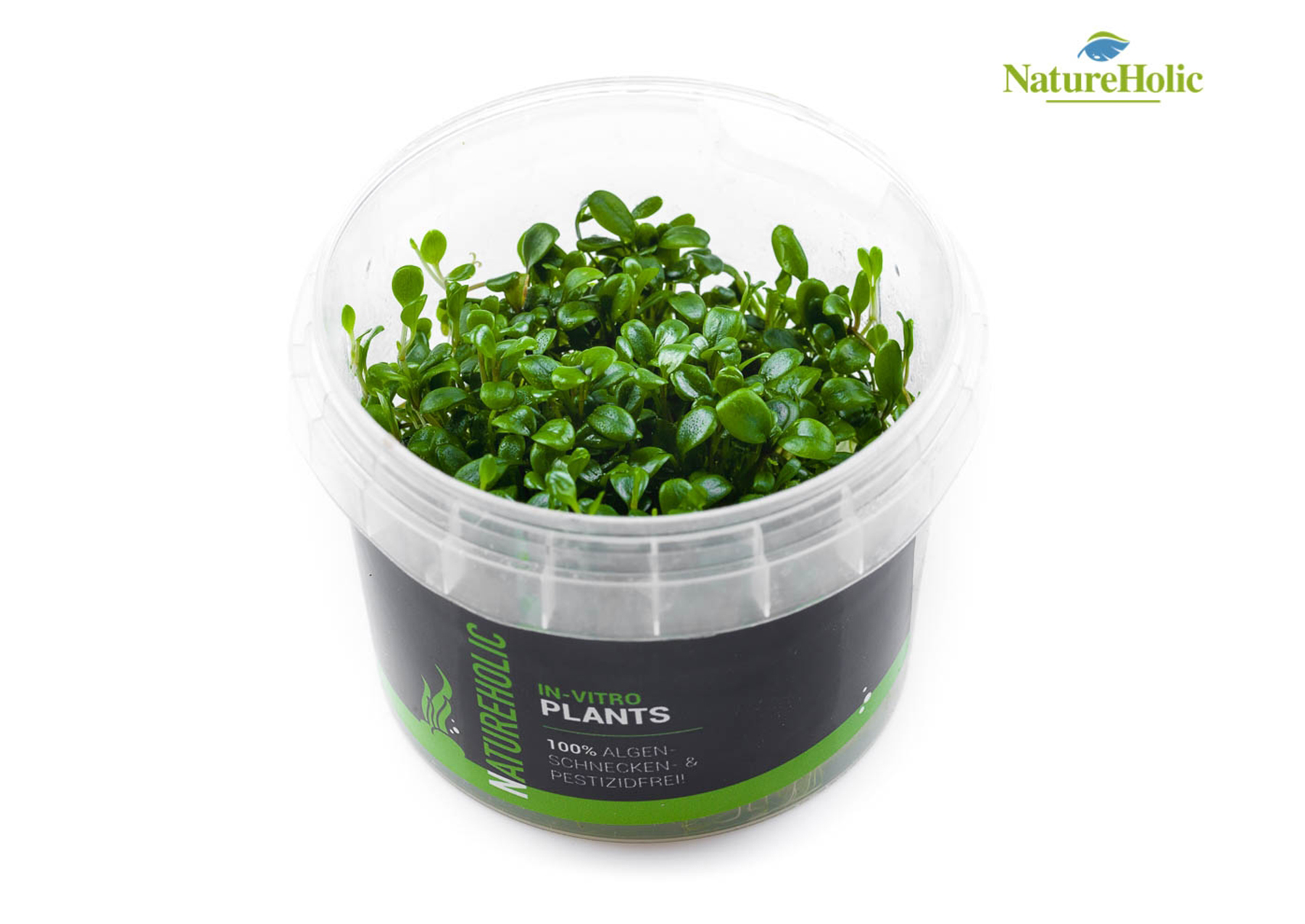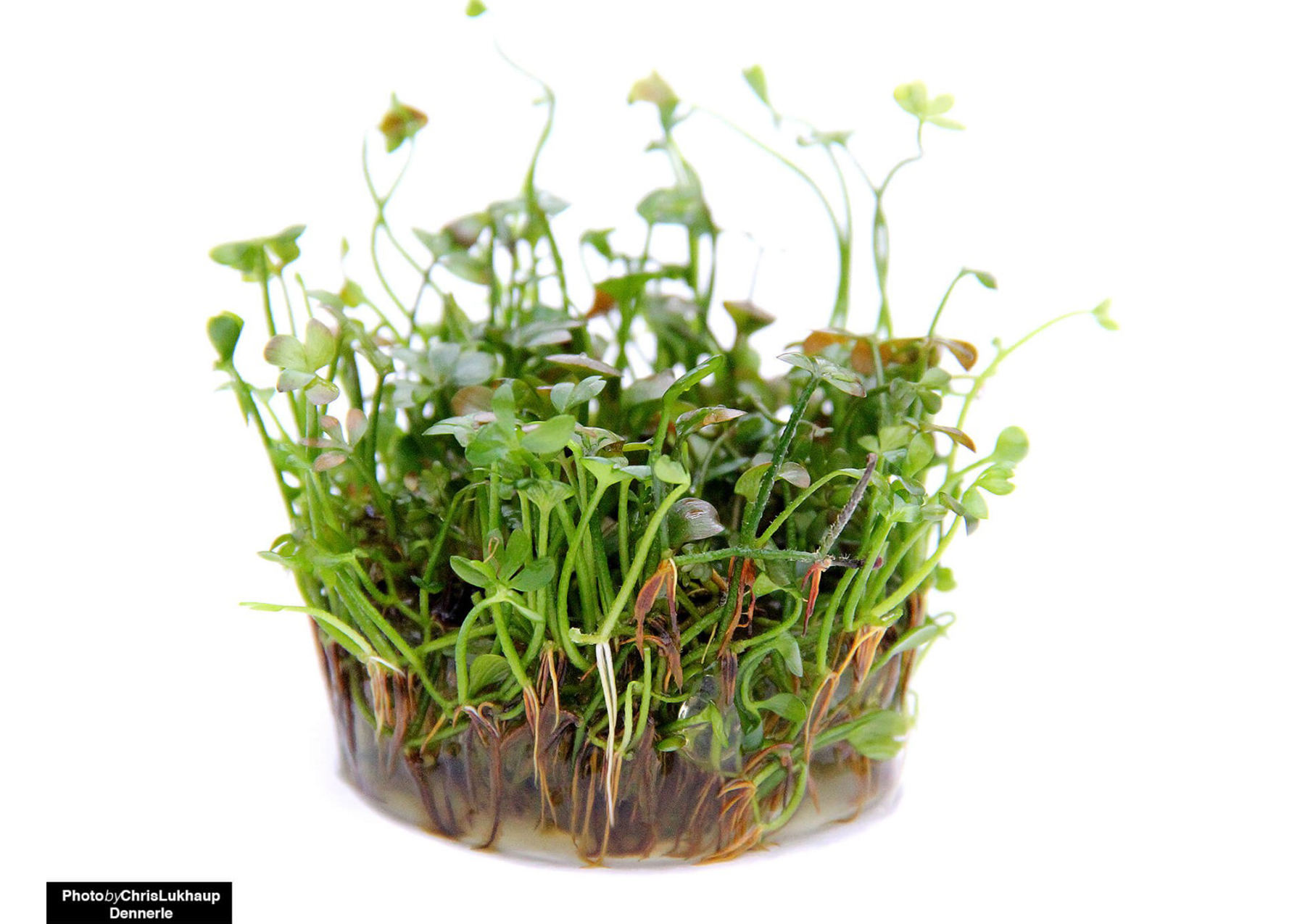The basics of aquarium plants: Foreground plants
Foreground plants
In addition to mosses, there are some well-suited aquarium plants for the design of the foreground in the aquarium that remain low. Foreground plants are low ground cover plants that are particularly good in the front area of the aquarium. These ground covers are rather flat in growth, growing only between 2 and 10 inches tall. For nano aquariums, you should use ground covers that grow to a maximum height of 5 cm - taller plants in the foreground would be too powerful, they would distract attention too much from the layout behind them. In large tanks, of course, you can place somewhat taller groundcover plants in the foreground.
Use in iwagumi
In addition to the classic use as ground cover in the foreground, low-growing plants with creeping growth and shoots lying on the ground are also used in iwagumi - a style of aquascaping that depicts a mountainous landscape surrounded by grassland. Here, the plants traditionally used in the foreground are planted virtually across the entire bottom surface of the aquascapes to represent a grassland landscape. In the early days, a single species of plant was used throughout the iwagumi, but this has now been somewhat abandoned - a mixture of different foreground plants, different leaf shapes alternating with grass-like plants, and different shades of green can bring life to the otherwise somewhat boring-looking iwagumi and contribute to a higher degree of naturalness.

Planting ground covers
When planting, groundcovers are not set as individual plants - the diminutive size of the plantlets coupled with the short, fine rootlets makes this an impossibility. The plants are potted out and the rockwool is removed as best as possible (it cannot be removed completely in these particular cases, the plants would be destroyed), for InVitro grown plants you rinse off the nutrient liquid or gel. Then divide the plants into smaller tuffs of 3-5 stems or 5-10 culms and place them quite deep into the substrate, preferably with tweezers. The rockwool remaining on the stalks acts as an anchor and holds the plantlets in the soil until they are rooted.
Care and pruning
For a dense lawn, the foreground plants are cut back regularly. This is best done with long, curved scissors specifically for aquascaping. Large areas are trimmed most gently with spring shears, whose blades open again and again by themselves thanks to the spring.
Strongly runner-forming species such as needle cress tend to grow in several layers on top of each other if they are simply left to do so - this quickly no longer looks nice and the lower layers of the plants then turn yellow. To avoid this, very densely growing stands should be thinned out generously from time to time.

The most popular plants for the foreground in the aquarium
In the following, we present the most popular low-growing aquarium plants for the foreground.
Grassy ground covers
Classic ground covers for the foreground in the aquarium are the grass-like plants, with which you can beautifully plant a lawn or even create a meadow landscape in an aquascape. There are taller plants for larger aquariums and lower plants for nanocubes and other nanoaquariums. The following applies to all grass-like plants: The adjustment to the new conditions in the aquarium is easier, especially for conventionally pot-grown plants, if you cut them down to about 1 cm stalk height before planting. The stalks die off anyway and the plant sprouts new shoots, and so the new shoots get light much faster and grow better.
Grass-like plants are planted by dividing the pots or even the InVitro grown portions into smaller pieces and sticking them into the soil 3-5 cm apart. Most grass-like ground covers propagate by runners, so the gaps are quickly filled. Propagate these plants by simply cutting off the runners with the daughter plants and planting them elsewhere.
Eleocharis pusilla / parvula - mini needle lime
The Mini Needle Sed ge is a grass-like growing aquatic plant that has fine light green slightly downward bent culms. With a maximum height of 3-5 cm, it is also nice to plant in the foreground in nanoaquariums. The Dwarf Needlewort originates from New Zealand and Australia. Forms runners.
The light requirement is medium to high, the mini needle lime gets along without CO2 fertilization. With a water hardness of 2-14 °dH and a water temperature of 12-28 °C you make the plant very happy.
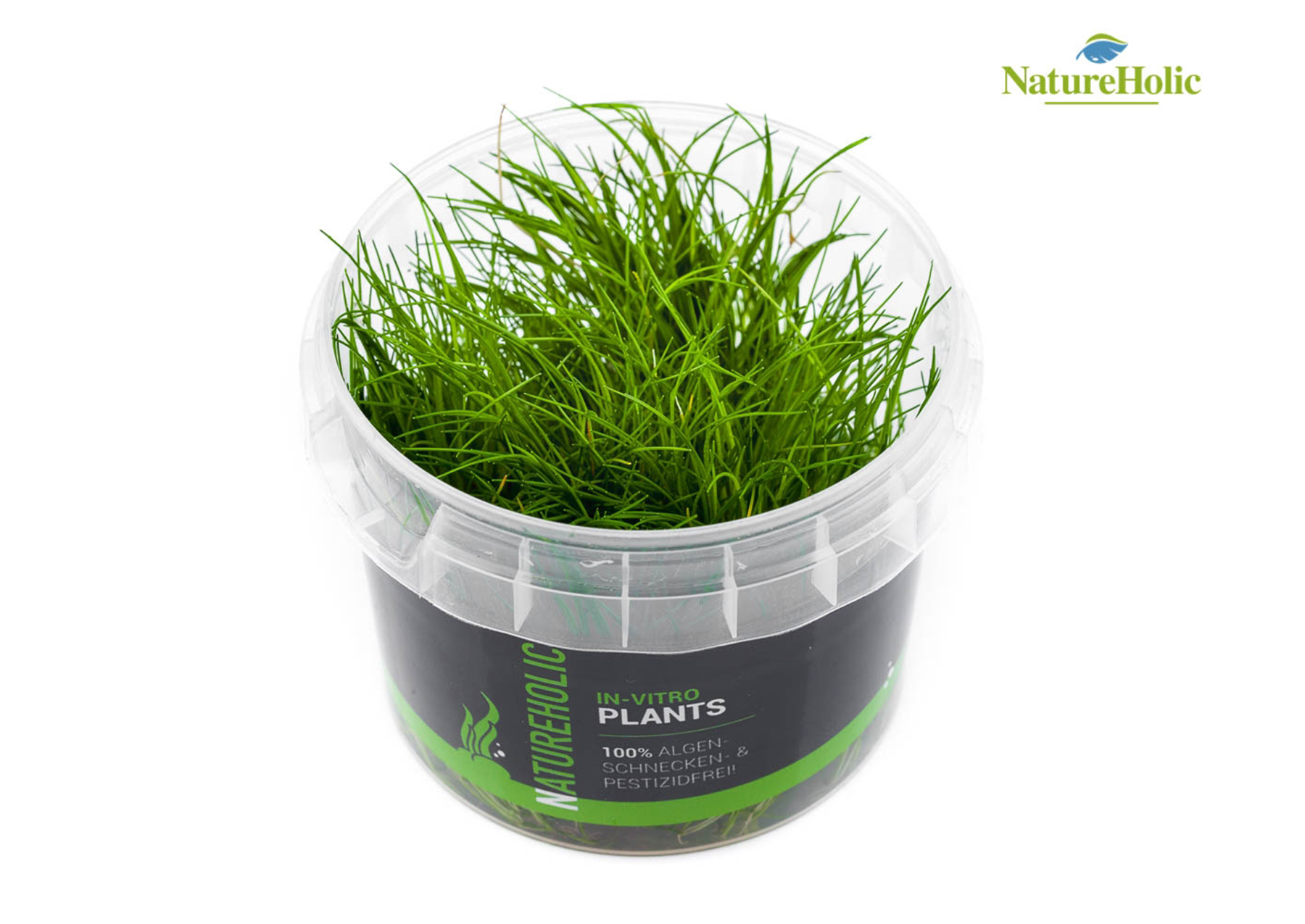
Eleocharis acicularis - needle lime
The needle lime was made famous by Takashi Amano. This great aquascaper often used this grass plant in his natural aquariums because it brings a very natural flair. With a growth height of about 5-7 cm it is a bit too tall for the foreground in nano aquariums (but beautiful for example in the middle ground), but perfect for larger aquariums.
The Needle Siskin is practically spread all over the world and is quite undemanding. It needs medium light, no additional CO2 and copes wonderfully with water temperatures of 12-28 °C and hardness of 2-14 °dH. The plant forms many runners and quickly fills gaps.

Eleocharis sp. "Mini" - Mini needle lime
It is not as "mini" as its name suggests - this Eleocharis species from North America grows to a height of 20-40 cm. Especially in very large aquariums it can be used to beautifully break up a carpet of the lower Needle Cormorant Eleocharis acicularis and tufts of this Eleocharis sp. "Mini" can be used as a solitary plant, eye-catcher in an otherwise low lawn landscape. The Mini Simse, like the other needle simses with a hardness of 2-14 °dH and a temperature of 12-28 °C, copes with a wide range of different environmental conditions. Medium light is sufficient, additional CO2 is not necessarily needed. Strong propagation by runners.
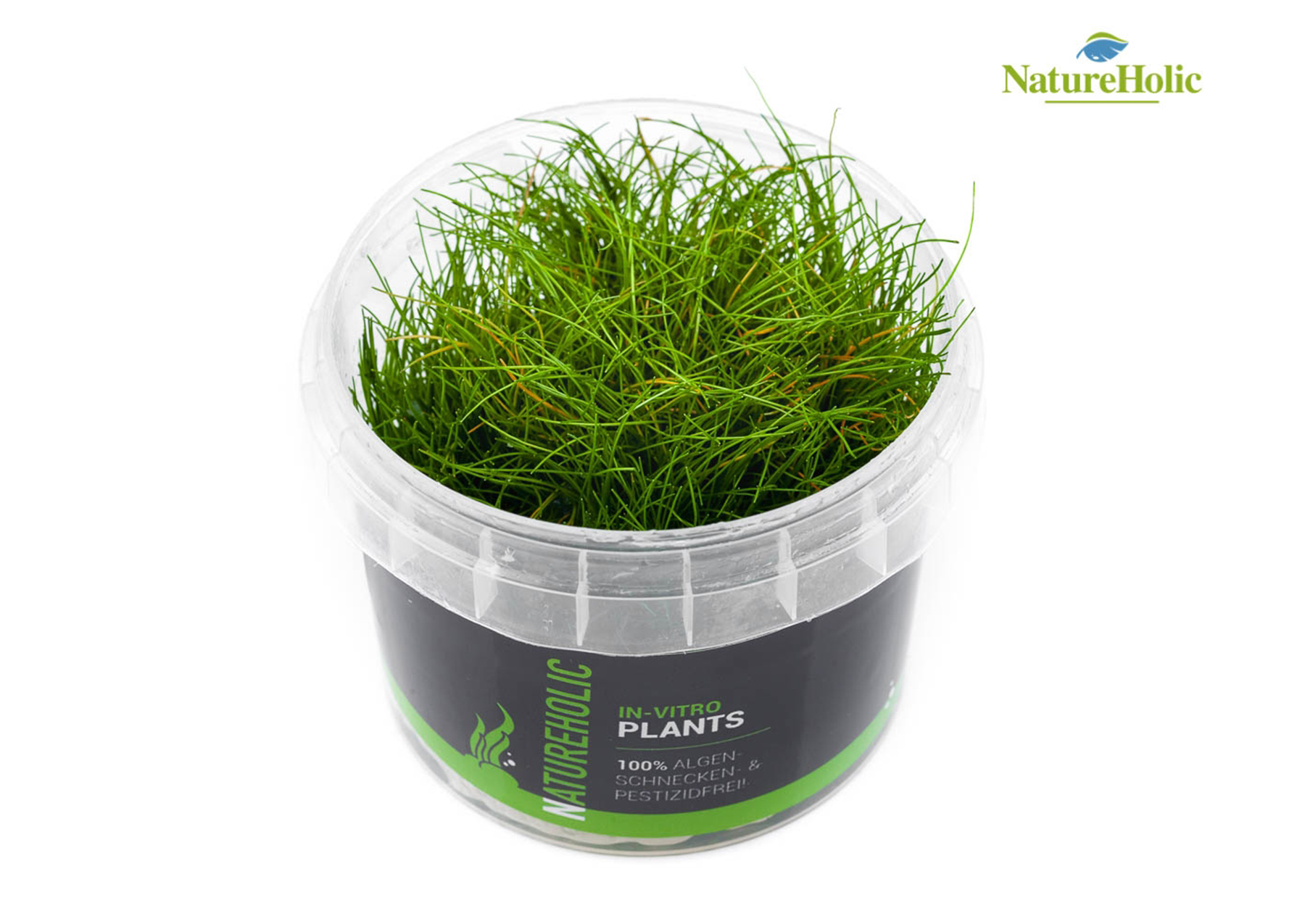
Blyxa japonica - Small blyx weed
Great grass plant from Asia for the foreground also in small aquariums and very well known by Takashi Amano and his Naturaquarium. Blyxa japonica needs a lot of light, a very good supply of micronutrients and macronutrients and absolutely an additional CO2 fertilization to grow healthy. It does not form runners, Blyxa japonica is propagated by cutting off and replanting the side shoots growing at the base. Small blyx weed needs soft water with hardness up to maximum 7 °dH and temperature 16-32 °C. Its growth height of 5-7 cm makes Blyxa japonica perfect for the middle ground in the nano and the foreground in aquariums with an edge length of 60 cm or more.
Utricularia graminifolia - Grassy Water Hose
With a maximum growth height of 3-5 cm, the grass-like water hose from the Asian region is a perfect lawn plant for the nano. As a carnivorous plant this Utricularia is once again special - but don't worry, for anything bigger than a freshly hatched hopper it is harmless, its trap bladders are really tiny.
Soft to medium hard water with a hardness of up to 12 °dH and a temperature of 16-28 °C make the Grasslike Water Hose a good choice for many aquariums. A CO2 fertilization should be present, the light should be at least medium. In the beginning, during the transition to the underwater form, the Grass-like Water Hose does easier if it is not illuminated with full intensity. Attention, sensitive to squeezing! Utricularia graminifolia spreads by runners.
Helanthium tenellum (Echinodorus tenellus) - Grass-like dwarf plant
Formerly, the fast-growing Grassy Dwarf Swordplant was listed as Echinodorus tenellus, but since it reproduces by runners, it has been placed in the new genus Helanthium. With a growth height of 6-8 cm, this grass-like sword plant fits beautifully as an accent plant in the foreground in the nano and of course as a lawn plant in aquariums with an edge length of 60 cm or more. It quickly fills the gaps in the foreground at 18-26 °C, medium to strong light and medium-hard water up to 14 °dH and multiplies rapidly via runners. A CO2 fertilization should be present, but is not a must.
Lilaeopsis brasiliensis - Brazilian grass plant
As the name suggests, the Brazilian Grass Plant comes from South America, more precisely from the southeast of Brazil, Chile and Paraguay. With a growth height of about 4-6 cm, this stolon forming grass-like foreground plant is perfect for nano aquariums as well as for larger aquascapes or planted aquariums. Lilaeopsis thrives optimally at 10-26 °C and in soft to medium hard water up to 14 °dH. CO2 is beneficial, but not absolutely necessary. The brighter the light, the lower the Brazilian grass plant will stay.
Ground cover with small leaves
Glossostigma elatinoides - Australian Tongue-leaf
Australian Tongue Leaf, or Glosso as it is affectionately known, grows to a dense, low carpet 2-3 inches tall in very good light and a proper CO2 supply; in less light the plants grow taller and look spindly. Takashi Amano liked to use Glossostigma as a ground cover in his natural aquariums. The fine shoots reproduce by runners and form dense populations under good conditions. A temperature of 4-30 °C and a water hardness up to 14 °dH are well suited. In nature Glosso grows in Australia and New Zealand in swamps and floodplains.
Marsilea hirsuta - Australian clover fern, dwarf cloverleaf, dwarf clover fern
The name "cloverleaf" or "clover fern" is somewhat misleading - the leaves of Marsilea hirsuta from Australia only look like cloverleaves when they are above water. Under water the dark green small leaves on the 1 cm short stems are simply egg-shaped, they only take on the clover leaf shape in low light and then also become somewhat larger. Marsilea forms runners and thus grows into a dense attractive carpet. The plant is quite frugal. 18-30 °C water temperature and soft to medium hard water up to 14 °dH are optimal, the clover fern does not need CO2.
Marsilea crenata - Mini Cloverleaf
The mini clover Marsilea crenata also comes from Australia. It grows in the same conditions as Marsilea hirsuta and also looks very similar to its sister species, both in leaf shape and growth height.
Marsilea angustifolia - Narrow-leaved clover, Narrow-leaved clover fern
The narrow-leaved clover fern Marsilea angustifolia comes from Australia. The overwater form of this clover fern also gives it its name. However, the four-leafed lucky clover leaves are somewhat narrower than those of other clover ferns. When the plant grows underwater, a narrow, short, medium green leaflet sits on a 1 cm stem. Like all other species of the genus Marsilea, the narrow-leaved clover fern forms runners. Thus, dense plant mats form relatively quickly in the aquarium, which look perfect in the foreground or even in the iwagumi. The narrow-leaved clover fern is not particularly demanding. It only needs medium light and likes soft to medium hard water. Additional fertilization with CO2 is not needed by the clover fern, although it can accelerate growth. The water temperature should be between 20 and 28 degrees.
Hemianthus callitrichoides - Cuba Dwarf Pearlwort
In strong light, the light green dwarf pear lwort from South America also remains quite low with 3-5 cm height. Even for a foreground plant, Hemianthus callitrichoides has extremely fine roots. In coarse gravel and even in coarse Soil the plant does not hold well at all, which is why you should either add a layer of fine Soil (Powder) over the normal Soil at the place where the dwarf pearlwort is to grow or tie the pearlwort onto flat stones. In time, it will take root on its own. Digging snails are counterproductive, at least in the beginning. It makes sense to buy Cuba Dwarf Pearlwort ready tied up on scape pads or planting stones. With CO2 and good lighting, at temperatures of 18-28 °C and a water hardness of 3-20 °dH, this smallest of all stem plants is a very beautiful cushion-forming ground cover for the foreground.
